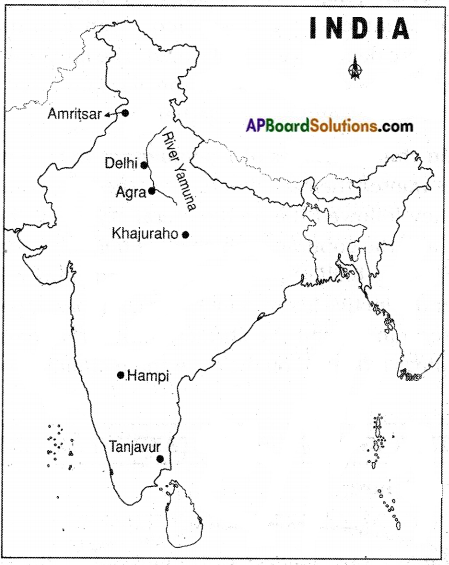 |
| AP Board Class 7 Social Studies Chapter 22 Rulers and Buildings Textbook Solutions PDF: Download Andhra Pradesh Board STD 7th Social Studies Chapter 22 Rulers and Buildings Book Answers |
Andhra Pradesh Board Class 7th Social Studies Chapter 22 Rulers and Buildings Textbooks Solutions PDF
Andhra Pradesh State Board STD 7th Social Studies Chapter 22 Rulers and Buildings Books Solutions with Answers are prepared and published by the Andhra Pradesh Board Publishers. It is an autonomous organization to advise and assist qualitative improvements in school education. If you are in search of AP Board Class 7th Social Studies Chapter 22 Rulers and Buildings Books Answers Solutions, then you are in the right place. Here is a complete hub of Andhra Pradesh State Board Class 7th Social Studies Chapter 22 Rulers and Buildings solutions that are available here for free PDF downloads to help students for their adequate preparation. You can find all the subjects of Andhra Pradesh Board STD 7th Social Studies Chapter 22 Rulers and Buildings Textbooks. These Andhra Pradesh State Board Class 7th Social Studies Chapter 22 Rulers and Buildings Textbooks Solutions English PDF will be helpful for effective education, and a maximum number of questions in exams are chosen from Andhra Pradesh Board.Andhra Pradesh State Board Class 7th Social Studies Chapter 22 Rulers and Buildings Books Solutions
| Board | AP Board |
| Materials | Textbook Solutions/Guide |
| Format | DOC/PDF |
| Class | 7th |
| Subject | Maths |
| Chapters | Social Studies Chapter 22 Rulers and Buildings |
| Provider | Hsslive |
How to download Andhra Pradesh Board Class 7th Social Studies Chapter 22 Rulers and Buildings Textbook Solutions Answers PDF Online?
- Visit our website - Hsslive
- Click on the Andhra Pradesh Board Class 7th Social Studies Chapter 22 Rulers and Buildings Answers.
- Look for your Andhra Pradesh Board STD 7th Social Studies Chapter 22 Rulers and Buildings Textbooks PDF.
- Now download or read the Andhra Pradesh Board Class 7th Social Studies Chapter 22 Rulers and Buildings Textbook Solutions for PDF Free.
AP Board Class 7th Social Studies Chapter 22 Rulers and Buildings Textbooks Solutions with Answer PDF Download
Find below the list of all AP Board Class 7th Social Studies Chapter 22 Rulers and Buildings Textbook Solutions for PDF’s for you to download and prepare for the upcoming exams:7th Class Social Studies 22nd Lesson Rulers and Buildings Textbook Questions and Answers
Improve Your Learning
Question 1.
How is the “trabeate” principle of architecture different from “arcuate”?
Answer:
Roofs, doors, and windows were made by placing a horizontal beam across two vertical columns. This style of architecture is called trabeate or corbelled. But in the arcuate style of architecture, the weight of the superstructure above the doors and windows was carried by arches. The roofs too used this principle and were converted into vaults and domes.
Question 2.
What is a Shikhara?
Answer:
The multi-storeyed towering gateway – built on the central shrines on a scale and height is called a Shikhara. These structures of immense scale must have been a mark of imperial authority. They were probably meant as reminders of the power of the kings, able to command the sources techniques, and skills needed to construct these towering gateways.
Question 3.
What are the elements of a Mughal Chahar bagh garden?
Answer:
In his autobiography, Babur described his interest in planning and laying out formal gardens, placed within rectangular walled enclosures and divided into four quarters by artificial channels. These gardens were called Chahar bagh four gardens, because of their symmetrical divisions into quarters. Beginning with Akbar some of the most beautiful Chahar baghs were .constructed by Jahangir and Shah Jahan in Kashmir, Agra and Delhi.
Question 4.
How did a temple communicate the importance of a king?
Answer:
The largest temples were all constructed by kings. They were meant to demonstrate the power, wealth, and devotion of the patron. The temple was a miniature model of the world ruled by the king all his allies. As they worshipped their deities together in the royal temples, It seemed as if they brought the just rule of the gods on earth. The king and nobles endowed the temples with land, gold, and jewels so that worship of the gods could be carried on a grand scale. These temples are thus the center of political and economic power.
Question 5.
Read the second part of the introduction part of page 189 and comment on it.
Between the eighth and the eighteenth centuries kings and their officers built two kinds of structures: The first were forts, palaces, and tombs – safe, protected, and grandiose places of rest in this world and the second were structures meant for public activity including temples, mosques, tanks, wells, caravanserais, and bazaars. Kings were expected to care for their subjects and by making structures for their use and comfort, rulers hoped to win their praise. Construction activity was also carried out by others, including merchants. They built temples, mosques, and wells. However, domestic architecture – large mansions (Havelis) of merchants – has survived only from the eighteenth century.
Answer:
During the period from 8 to 18th century, the kings were interested in construction activity. They constructed forts, palaces, tombs, temples, mosques, tanks, wells, etc. They constructed them as a mark of their art and architecture.
Question 6.
How did the Mughal court suggest that everyone – the rich and the poor, the powerful and the weak – received justice equally from the emperor?
Answer:
The connection between royal justice and the Imperial Court was emphasized by Shah Jahan in his newly constructed court in the Red Fort at Delhi. The construction of Shah Jahan’s audience hall aimed to communicate that the King’s justice would treat the high and the low as equals where all could live together in peace and harmony.
Question 7.
The rich and the powerful construct large houses today. In what ways were the constructions of kings and their courtiers different from them?
Answer:
Though the houses built by the rich and powerful nowadays are very large, they don’t have any beautiful gardens. Mughal nobility had constructed their homes on the banks of the river – Yamuna. These were set in the midst of formal gardens constructed in the Chahar bagh format.
Question 8.
Is there a statue or a memorial in your village or town? Why was it placed there? What purpose does it serve?
Answer:
Yes, there is Dr. B. R. Ambedkar’s statue in our village. It was placed by some of our villagers. It is to honor him as a framer of our Constitution.
Question 9.
Visit and describe any park or garden in your neighborhood. In what ways is it similar to or different from the gardens of the Mughals?
Answer:
There is a park at the end of our street. Our park is in a rectangular shape. There is a compound wall around the park. There are no channels in our park. But there is a tap to water the plants.
Moghul gardens are in a rectangular shape. They are placed within walled enclosures constructed by Babur. They are divided into four quarters by artificial channels.
Question 10.
Locate the following on the India India map.
a) Delhi
b) Agra
c) Amritsar
d) Tanjavur
e) Hampi
f) River Yamuna
g) Khajuraho
Answer:
AP Board Textbook Solutions PDF for Class 7th Social Studies
- AP Board Class 7
- AP Board Class 7 Social Studies
- AP Board Class 7 Social Studies 1st Lesson The Universe and The Earth
- AP Board Class 7 Social Studies 2nd Lesson Forests
- AP Board Class 7 Social Studies 3rd Lesson Learning Through Maps
- AP Board Class 7 Social Studies 4th Lesson Delhi Sultanate
- AP Board Class 7 Social Studies 5th Lesson Kakatiya Kingdom
- AP Board Class 7 Social Studies 6th Lesson Vijayanagara Empire
- AP Board Class 7 Social Studies 7th Lesson Mughal Empire
- AP Board Class 7 Social Studies 8th Lesson Bhakthi Sufi
- AP Board Class 7 Social Studies 9th Lesson Indian Constitution
- AP Board Class 7 Social Studies 10th Lesson State Government
- AP Board Class 7 Social Studies 11th Lesson Road Safety Education
- AP Board Class 7 Social Studies 12th Lesson Markets Around Us
- AP Board Class 7 Social Studies 13th Lesson Women Change the World
- AP Board Class 7 Social Studies Chapter 1 విశ్వం మరియు భూమి
- AP Board Class 7 Social Studies Chapter 2 అడవులు
- AP Board Class 7 Social Studies Chapter 3 పటాల ద్వారా అధ్యయనం
- AP Board Class 7 Social Studies Chapter 4 ఢిల్లీ సుల్తానులు
- AP Board Class 7 Social Studies Chapter 5 కాకతీయ రాజ్యం
- AP Board Class 7 Social Studies Chapter 6 విజయనగర సామ్రాజ్యం
- AP Board Class 7 Social Studies Chapter 7 మొఘల్ సామ్రాజ్యం
- AP Board Class 7 Social Studies Chapter 8 భక్తి – సూఫీ
- AP Board Class 7 Social Studies Chapter 9 భారత రాజ్యాంగం – పరిచయం
- AP Board Class 7 Social Studies Chapter 10 రాష్ట్ర ప్రభుత్వం
- AP Board Class 7 Social Studies Chapter 11 రహదారి భద్రత
- AP Board Class 7 Social Studies Chapter 12 మన పరిసరాలలో ఉన్న మార్కెట్లు
- AP Board Class 7 Social Studies Chapter 13 ప్రపంచ పరివర్తనలో మహిళలు
- AP Board Class 7 Social Studies Chapter 1 Reading Maps of Different Kinds
- AP Board Class 7 Social Studies Chapter 2 Rain and Rivers
- AP Board Class 7 Social Studies Chapter 3 Tanks and Ground Water
- AP Board Class 7 Social Studies Chapter 4 Oceans and Fishing
- AP Board Class 7 Social Studies Chapter 5 Europe
- AP Board Class 7 Social Studies Chapter 6 Africa
- AP Board Class 7 Social Studies Chapter 7 Handicrafts and Handlooms
- AP Board Class 7 Social Studies Chapter 8 Industrial Revolution
- AP Board Class 7 Social Studies Chapter 9 Production in a Factory A Paper Mill
- AP Board Class 7 Social Studies Chapter 10 Importance of Transport System
- AP Board Class 7 Social Studies Chapter 11 New Kings and Kingdoms
- AP Board Class 7 Social Studies Chapter 12 The Kakatiyas
- AP Board Class 7 Social Studies Chapter 13 The Kings of Vijayanagara
- AP Board Class 7 Social Studies Chapter 14 Mughal Empire
- AP Board Class 7 Social Studies Chapter 15 Establishment of the British Empire in India
- AP Board Class 7 Social Studies Chapter 16 Making of Laws in the State Assembly
- AP Board Class 7 Social Studies Chapter 17 Implementation of Laws in the District
- AP Board Class 7 Social Studies Chapter 18 Caste Discrimination and the Struggle for Equality
- AP Board Class 7 Social Studies Chapter 19 Livelihood and Struggles of Urban Workers
- AP Board Class 7 Social Studies Chapter 20 Folk Religion
- AP Board Class 7 Social Studies Chapter 21 Devotional Paths to the Divine
- AP Board Class 7 Social Studies Chapter 22 Rulers and Buildings






0 Comments:
Post a Comment